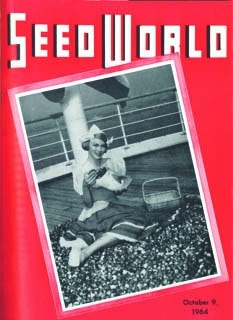A Moment In Time

Editor Percy Stelle notes that up until the 1960s, surplus crops had been a problem in only a few countries. “In many other parts of the world, millions of people go to bed hungry every night. Indications are that as world population rises, the food shortage is going to become increasingly acute in some countries, and our own population increase is likely to supply a market for much of our surplus unless the trend toward higher crop production per acre continues.”
Facts and Figures from this 1964 Issue:
$25 is the average cost of a bushel of alfalfa in Iowa.
$28.4 million is the value of seed exports from 1963-64, a new record.
284,8305 pounds of field seeds are imported into Canada in August.
6.3% is the rate of corporate taxes after income that year.
90% of cereal and soybean seeds planted that year are estimated to be farm-saved.
Excerpts from this Issue
Seed Legislation and Good Seed
By L.E. Everson, Iowa State University
Results from seeder box surveys in many states indicate that seed sold in farm-to-farm sales is often low in quality. And for certain kinds of crop seeds, such as cereals and soybeans, up to 90 percent of the seed planted is homegrown (the farmer’s own seed or purchased from his neighbor).
Fred Casterline Jr. of Casterline & Sons Seeds Inc. informed the Kentucky Seed Dealers that, “The biggest reasons for the large acreage still planted with untested seed is the direct result of specific exemptions in state seed laws that permit farmers to sell untested seed to other farmers. The same laws that prohibit the sale of untested seed by seed wholesalers and retailers who are far more qualified to gauge seed quality than are the farmers. What is needed to correct this situation? First, we need legislation that will make the seed producers equally responsible for the quality of their seed. The seed laws should be changed to make everyone who sells seed test it before a sale can be made. The second way is through education.”
It doesn’t make sense for seed law enforcement officials to be concerned about the 10 percent of cereal grains and soybeans sold by seed dealers and forget the other 90 percent. They should be concerned about the entire 100 percent.
Now is the time to act if your state needs new legislation to remove these exemptions. Does your state have a seed council? A seed council should include representatives of seed law enforcement officials, seed dealers, state seed laboratory, crop improvement associations, state agricultural college and farmers’ organizations.
If you already have a state seed council, you are in a position to act. What amendments are needed? Seedsmen are against farm seed sale exemptions as a matter of principle, since the law favors one group over another. There was a time when these exemptions were justifiable. When roads, seedsmen and seed testing facilities were few and far between, it was sometimes impossible to obtain tested and labeled seed. But this is no longer true.
Why should one group be exempted from the requirements of the law? Both seedsmen and farmers sell seed. Where should the line be drawn between the seedsman and farmer, and why?
Planting Ideas in People
By Richard N. Meltzer, Richard N. Meltzer Advertising Inc.
Planting ideas used to be a person-to-person sort of thing. Now it’s a $12 billion-a-year industry called advertising, complete with planning committees, creative plans boards, motivational research teams and clients.
Idea planting for me is a full-time job. The amount of money we make, the amount of self-respect we must muster, amount of fun we get out of our job, is all dependent on the quality of and duration of the ideas we plant in the minds of people on behalf of our clients.
To ignore outside competition can be fatal in the long run. Pick your strongest competitor and begin planting ideas in people’s minds that beat his competition make them want to join him. One of our clients is Podesta Baldocchi, the world’s most famous florist and fastest companies to spot a trend.
That trend is the trend back to city living. Podesta Baldocchi took one look at the growth of apartment buildings and realized nothing green was growing there and mini-gardens were needed. They renamed their seed packets Balcony Garden Packets.
Ask yourself, “What are people doing with their time instead of planting seeds?” Seed is one of those rare products that doesn’t cost much. The fact it’s also a product that appeals to all five senses points very strongly toward the direction your promotions should go.
Plant the idea that seeds fit in with the new kind of life we lead. There are many ways to do this. Your seed pack is your best advertisement. By all means, show the fruit or flower or vegetable, but add some sell to the packet. Make it so the person who picks it up can’t put it down again. Your pack is your ad.
There is no better time to plant ideas in the mind of your customer than when your seed packet is in their hand.
Genetic Characteristics May Double Protein Value of Corn
Purdue University researchers reported recently that they have found a genetic characteristic which could double the protein value of corn — a discovery which promises to revolutionize corn’s importance in nutrition. The biochemist and geneticist who made this discovery say a mutant gene called opaque-2 is responsible. It produces a corn with radical changes in protein makeup and in the pattern of amino acids.
“Based on the chemical analysis,” explains Purdue biochemist Dr. Edwin T. Mertz, “we would predict that the new corn ought to have a protein value approximately double that of ordinary corn.”
The boost in protein quality can be attributed to an increase in lysine, the limiting essential amino acids in corn. The new corn has about twice the lysine level of normal hybrid corn.
At Purdue, a search for corn with a higher lysine level has been underway about 10 years. Kernels from various parts of the country and other nations were put through complicated protein extraction tests, but most showed only small variances of lysine.
Last fall, researchers found what they were looking for. Mutant kernels with the opaque-2 gene showed a marked increase in lysine. Succeeding tests demonstrated that the lysine level varied slightly, but was always higher than in normal seeds.
According to researchers, incorporation of the gene into commercially important inbreds and building up stock of inbreds and single crosses will take five to six years if two generations each year are obtained. No feeding tests have been made as yet, but assuming the new corn has the same digestibility as ordinary corn, Mertz expects it would have a higher nutritional value.












